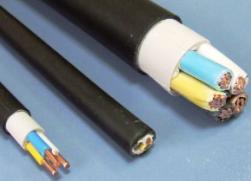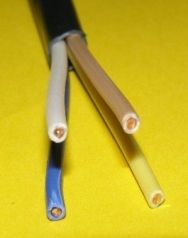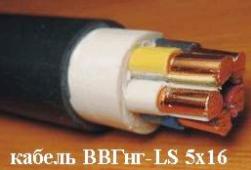Categories: Featured Articles » Novice electricians
Number of views: 340575
Comments on the article: 13
Marking electrical wires and cables
 The modern assortment of wires and cables is quite wide. The buyer is presented with a large assortment of cable and wire products of various designs of cores, as well as with different insulation coatings. As a rule, all conductors and cables are specially marked, which shows the characteristics of a product. Below is a breakdown of the most common brands of wires and cables.
The modern assortment of wires and cables is quite wide. The buyer is presented with a large assortment of cable and wire products of various designs of cores, as well as with different insulation coatings. As a rule, all conductors and cables are specially marked, which shows the characteristics of a product. Below is a breakdown of the most common brands of wires and cables.
Alphanumeric marking of cables and wires
Electrical cables and wires are marked with letters and numbers. Consider the letter abbreviations, that is, the marking that is used to designate cables with polyvinyl chloride (PVC) and rubber insulation in accordance with GOST 16442-80, TU 16.K71-335-2004, TU16.71-277-98.
“A” (first letter) - indicates the material of the core, in this case aluminum, and in the absence of this letter the material is copper.
"AC" - an aluminum core with an additional cable sheath made of lead.
"AA" - an aluminum core with an additional aluminum sheath of a cable.
"B" - indicates that this cable has a protective armor, which is made of two layers of steel tape with a corrosion-resistant coating. If the letter “n” stands, that is, the marking has the form “Bn”, then the steel shell has a special protective shell that does not support combustion. Letter "b" - the armor is made of profiled steel bands.
 "B" - the first (in the presence of the first "A" - the second) - polyvinyl chloride insulation, the second (in the presence of the first "A" - the third) - polyvinyl chloride shell.
"B" - the first (in the presence of the first "A" - the second) - polyvinyl chloride insulation, the second (in the presence of the first "A" - the third) - polyvinyl chloride shell.
“G” - at the end of the marking - a “bare” cable that does not have a protective cover. If the letter "G" is at the beginning of the marking, then this cable is used in the mining industry. The lowercase letter "g", as a rule, is placed at the end of the marking and indicates that the metal screen of the cable is sealed with a water-repellent tape. Marking "2g" - the presence of an additional aluminopolymer tape.
“Shv” - the presence of a cable sheath in the form of a molded PVC hose. “Shp” - the hose is made of polyethylene, “Shp” - polyethylene, of which the hose is self-extinguishing.
“K” - at the beginning of the marking indicates that the cable is control. “K” at the end of the marking - the armor of the cable is made of round steel wires, a protective cover is dressed on top of them.
"C" is the lead sheath of the cable. “O” - the sheath is made on top of each phase of the cable.
"P" - cable insulation made of rubber. If the letter H is in front (marking “НР”), then the cable insulation does not support combustion.
Marking "ng" at the end - does not support combustion.
The numerical values in the cable marking show the number of cores and their cross-section. For example, 3x2.5 - three cores with a cross section of 2.5 square millimeters.
Decoding examples of alphanumeric labeling of cables and wires
For clarity, we give a few examples of markings of the most common cable brands.
AVVGng 3x4 - a three-core cable with aluminum conductors with a cross-section of 4 squares, with a sheath and insulation of polyvinyl chloride, without a protective cover, which does not support combustion.
PVG 3x2.5 - a three-core cable with copper conductors with a cross-section of 2.5 squares, with polyethylene insulation, a protective sheath of polyvinyl chloride, the cable does not have a protective cover.
ASB 7x2.5 - a seven-core cable with aluminum conductors with a cross-section of 2.5 squares, in a lead sheath, the cable has armor, which is made of two steel bands that are not subject to corrosion.
 Very often there are cable markings that contain English letters: HF and LS - they indicate a low level of gas and smoke emission, respectively. For instance, VVGNG-LS-HF.
Very often there are cable markings that contain English letters: HF and LS - they indicate a low level of gas and smoke emission, respectively. For instance, VVGNG-LS-HF.
Wire marking is somewhat similar to cable marking, but it has some differences.
We give examples of marking the most common wires and cords in accordance with GOST 7399-97.
SIP - self-supporting insulated wire, the insulation of which is made of light stabilized polyethylene cross-linked type.
A is an aluminum wire that does not have an insulating coating. This wire is made of many individual wires.
AC - steel-aluminum wire that does not have an insulating coating. Structurally, it is made of separate wires that are located on a steel core (wire base). PVA - a wire with a PVC sheath and insulation, flexible, with twisted type conductors.
STEP - a cord with PVC insulation, with a parallel arrangement of cores, especially flexible.
PPV (APPV) - a wire with copper (aluminum) flat conductors, with single-layer PVC insulation.
Color coding of cables and wires
In addition to alphanumeric marking of wires and cables, there is a color marking. Below we list the colors that mark the wire and the corresponding purpose of the core:
-
blue - zero (neutral) wire;
-
yellow-green - protective conductor (ground);
-
yellow-green with blue marks - grounding conductor, which is combined with zero;
-
black - phase wire.
In addition, in accordance with the PUE, the use of a different color for a phase conductor, for example, brown, is allowed.
When purchasing a cable, pay attention to the color coding of the cores, as in reality it may not meet the requirements. Conformity of the colors of the cores to generally accepted standards is, first of all, convenience during installation and further maintenance of wiring.
In any case, the color coding of the cores does not affect the quality cable products. Therefore, if you purchased a cable (wire) with a non-standard color of conductors, then before installing it, decide which color will correspond to which conductor.
Read more about the color marking of wires here:Rules for designating wires by color
See also at i.electricianexp.com
:
